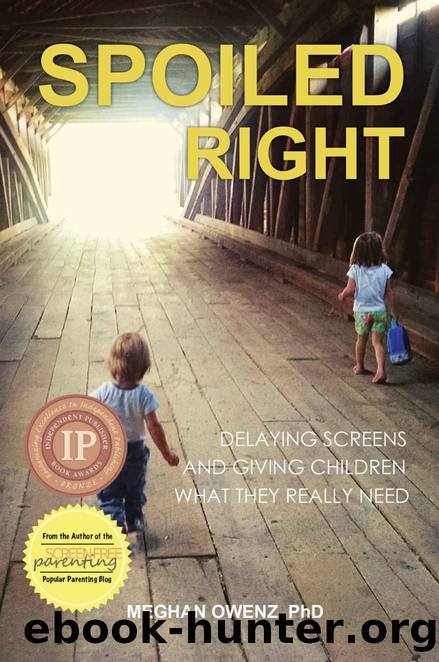epub-spoiled right 1-1-2021 by Owenz Meghan

Author:Owenz, Meghan
Language: eng
Format: epub
Publisher: Praeclarus Press
Published: 2021-01-11T00:00:00+00:00
The LiiNK program, which started in Texas and is spreading throughout the United States, is just one proposed solution to our problem of insufficient outdoor time during the school day. Angela Hanscom, a pediatric occupational therapist, strongly advocates for an hour-long recess each day to give children sufficient time to become involved in elaborate creative play schemes and develop the social-emotional skills necessary to negotiate a conflict during such a game (Hanscom, 2014). There are entire schools devoted to nature, like nature preschools and nature kindergartens. It is estimated that the number of ânature-based preschoolsâ has grown 500% since 2012 (Williams, 2018).
There are alternative schooling philosophies, like the Waldorf approach, which have always emphasized the child in nature. Clearly, there is a need for more opportunities to interact with nature during the school day, and parents and school officials are starting to advocate for it. Hopefully, more of these movements will become mainstream, and we will see more physical activity and time in nature for all students.
Focus on Physical Exercise
The drive to get more physical activity for children is often confused with the need for children to spend more time outdoors. In confusing the two, we have turned time outside into an instrumental goal: a means to an end. It is important to understand the little beings we are attempting to educate are far wiser about time in nature than the average adult. Time outdoors in nature, for children, is a constitutive activity. There is no end goal. They are active, yes, but at times, they are also observant, quiet, and reflective.
For children, the goal is not to go outside to get their daily 60 minutes of moderate-to-vigorous aerobic activity. Itâs just that when they are outside, they are often not constrained by the âbe quietâ and âsit stillâ rules that dominate the indoor world, and therefore, they run when they see something exciting or when they are being chased. They climb on the playground or the tree. They burrow under a bush or through a tunnel.
If these two movements are being confused, it is out of desperation. The amount of time children spend outdoors and in physical activity is so limited that advocates for both tend to muddle the goal a bit, just because we would all be happy to see kids both more active and outdoors. Additionally, while many of us recognize that there are immense benefits to time spent in nature beyond physical activity, benefits like reduced stress, concern for the planet, and improved sleep, we all know that the argument that time spent in nature will increase physical activity which will decrease obesity is the best instrumental argument to getting what we want: the opportunity for our children to breathe fresh air.
However, like the American Academy of Pediatrics in their policy statement on the issue, we must be careful to recognize that physical education and time outdoors are not one and the same. They are not interchangeable. They are both necessary for different reasons. If we
Download
This site does not store any files on its server. We only index and link to content provided by other sites. Please contact the content providers to delete copyright contents if any and email us, we'll remove relevant links or contents immediately.
Letter to My Daughter by Maya Angelou(1469)
Dog Training 101 by Kyra Sundance(1286)
The Whole Lesbian Sex Book by Felice Newman(1152)
The Unofficial Guide to Walt Disney World with Kids 2017 by Bob Sehlinger(1031)
Art Lab for Little Kids (Lab Series) by Susan Schwake(985)
The Pizza Party by Theo Baker(936)
Playful Parenting by Cohen Lawrence J(916)
Encyclopedia of Infant and Toddler Activities by Kathy Charner(914)
Talking with Your Toddler by Teresa Laikko(904)
Circus by unknow(900)
The Budding Chef by Kate Kuhn(886)
The Big Book of Nature Activities by Jacob Rodenburg(846)
Welding for Dummies by Welding(836)
The Sense of Wonder by Rachel Carson(824)
The Creative Family Manifesto by Amanda Blake Soule(819)
Four Great Americans: Washington, Franklin, Webster, and Lincoln (Yesterday's Classics) by Baldwin James(787)
Zen Mind, Beginners Mind by Shunryu Suzuki(779)
365 Games Smart Toddlers Play: Creative Time to Imagine, Grow and Learn by Sheila Ellison(774)
The Arts & Crafts Busy Book by Trish Kuffner(765)
